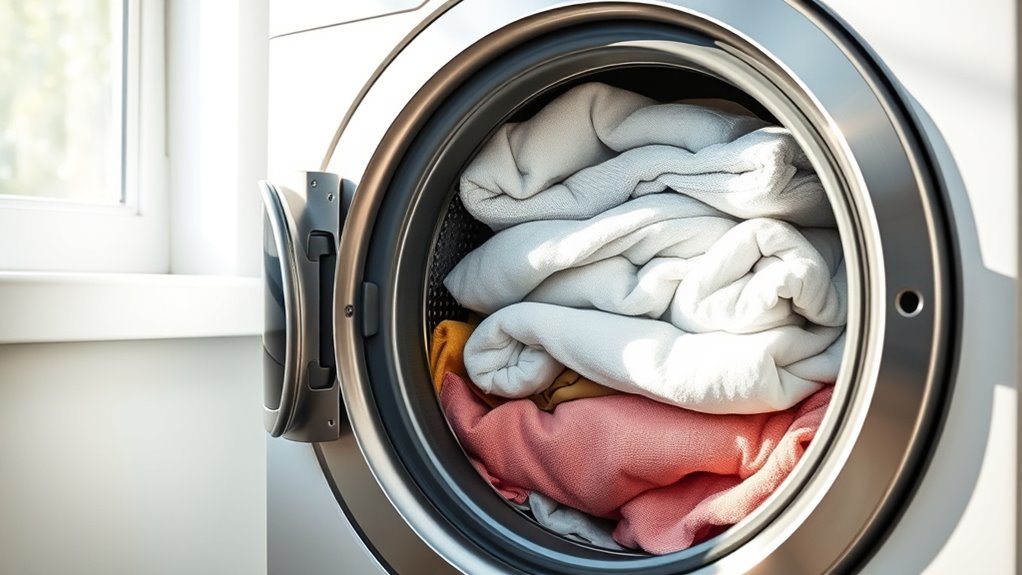Filling your washer with full loads is more energy efficient because it reduces the number of cycles needed to clean your clothes, saving electricity and water. When you load the washer properly, you use less energy per item and prevent unnecessary wear on the machine. Opting for full loads also minimizes cycle frequency, extending your appliance’s lifespan. Keep exploring to discover more ways to maximize your laundry’s efficiency and save energy.
Key Takeaways
- Full loads maximize washer capacity, reducing the number of cycles needed and conserving energy per use.
- Washing larger loads at once decreases the frequency of cycles, saving water and electricity.
- Using eco-friendly detergents and cooler temperatures in full loads lowers energy consumption for heating and cleaning.
- Properly maintained appliances operate more efficiently, minimizing energy waste during each cycle.
- Drying full loads with moisture sensors reduces over-drying, saving energy and extending the lifespan of the dryer.

Maximizing your energy efficiency starts with understanding the importance of washing or drying full loads. When you load your washer properly, you make the most of its capacity, often referred to as washer capacity. Choosing a machine with an appropriate capacity for your household helps guarantee you’re not wasting energy on partial loads. Washing small loads frequently can lead to higher energy consumption because the machine runs more often, using as much power as it does for larger loads. Instead, aim to fill your washer to its ideal capacity, which allows you to clean more laundry using less energy per item. This approach not only conserves electricity or water but also reduces wear and tear on your appliance, extending its lifespan. Utilizing vertical storage solutions can help you organize laundry supplies efficiently, making it easier to manage full loads and streamline your laundry routine.
Full loads save energy, water, and extend appliance lifespan.
Another key aspect of maximizing energy efficiency is selecting eco-friendly detergents. These detergents are formulated to work effectively at lower temperatures and in smaller quantities, which means you can wash full loads at cooler settings without sacrificing cleaning power. Using eco-friendly detergents aligns with your goal of reducing energy consumption since washing at lower temperatures requires less heat, directly cutting down on energy use. furthermore, because these detergents are often concentrated, you don’t need to use as much product per load, further enhancing your efficiency. When combined with full loads, eco-friendly detergents help you achieve a cleaner result while minimizing your environmental impact.
In addition to choosing the right detergent and load size, pay attention to your washer’s settings. Opt for eco or energy-saving cycles that are designed to reduce water and energy consumption. These cycles are optimized to clean effectively while using less power, especially when your loads are full. Avoid running your washer or dryer multiple times for small loads, which can quickly add up in energy costs. Instead, wait until you have a full load to make the most of each cycle, saving both money and resources. Properly maintaining your appliances, such as regularly cleaning filters and seals, can also enhance their efficiency and longevity.
Drying your laundry efficiently also benefits from this mindset. When you dry full loads, your dryer operates more efficiently, using less energy per item. If your dryer has a moisture sensor, use it to prevent over-drying, which wastes energy. Combining full loads with proper cycle selection and eco-friendly detergents creates a streamlined process that minimizes energy use without compromising cleanliness. By understanding your washer’s capacity and choosing environmentally friendly cleaning products, you can greatly reduce your household’s energy footprint while keeping your clothes fresh and clean.
Frequently Asked Questions
Do Full Loads Save More Water Than Partial Loads?
Yes, full loads save more water than partial loads. When you wash a full load, you’re promoting water conservation by using available capacity efficiently. This also improves detergent efficiency since the detergent is evenly distributed across more items, reducing wastage. By always washing full loads, you help preserve water and ensure your detergent works effectively, making your laundry routine more eco-friendly and cost-efficient.
How Does Load Size Affect Appliance Lifespan?
You extend your appliance lifespan by maintaining proper load size and load distribution. Overloading causes strain on components, leading to faster wear and tear, while underloading can cause inefficient operation. Regular appliance maintenance helps identify issues early and guarantees peak performance. By balancing your loads and caring for your appliances, you prevent unnecessary stress, reduce breakdowns, and prolong their useful life, saving you money and hassle over time.
Are Energy-Efficient Appliances Better for Small Loads?
Yes, energy-efficient appliances are better for small loads because they promote energy conservation and optimize appliance performance. Many energy-efficient models are designed to handle smaller loads without wasting power, which helps you save on electricity bills and reduces environmental impact. By choosing these appliances, you guarantee that each use is as efficient as possible, making your household more sustainable and cost-effective, even when you’re washing or cleaning just a few items.
Can Overloading Reduce Washing Machine Efficiency?
Overloading your washing machine can reduce its efficiency because it causes overloading consequences like increased wear and tear, which strain the motor and drum. This can lead to uneven washing and longer cycles. To maintain peak performance, you should follow washing machine maintenance tips and avoid overloading. Properly loaded machines operate more efficiently, saving energy and prolonging the appliance’s lifespan.
What Is the Optimal Load Size for Dryers?
You should aim for about 75% of your dryer’s load capacity to optimize drying efficiency. Overloading hampers airflow and increases drying time, wasting energy. Conversely, underloading isn’t efficient either, as it doesn’t utilize the dryer’s full potential. Endeavor for a balanced load that maximizes drying efficiency without overburdening the machine. This ensures your clothes dry faster and save energy in the process.
Conclusion
By always filling your laundry and dishwasher loads, you’re steering your appliances like a ship through calmer waters, avoiding the storm of wasted energy. Full loads maximize efficiency, helping you save money and reduce your carbon footprint. Think of it as squeezing the last drop from a sponge—every bit counts. So, make a habit of waiting for full loads, and you’ll find that small change making a big ripple in both your wallet and the planet.









